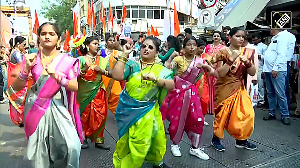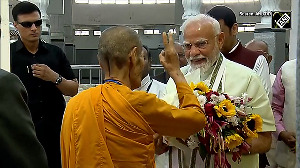The most fascinating characteristic of India is that, even for Indians, it takes on different complexions at different points of time, as if one is looking through a kaleidoscope. One cannot put a finger on any particular description and say that that is what definitively represents India.
To start with, it is a continent within a continent. Indeed, there is not one India to deal with but horizontally five and vertically three: The relatively forward and steady-state India comprising the southern states, Maharashtra, Gujarat, Punjab, Haryana and West Bengal; the BIMARU (just a letter of the alphabet changes it to bimari meaning disease in Hindi) India, consisting of the states of Bihar, Madhya Pradesh, Rajasthan and Uttar Pradesh, grovelling (or revelling?) in backwardness judged by every parameter; the seven sisters of the north-east -- Arunachal Pradesh, Assam, Manipur, Meghalaya, Mizoram, Nagaland and Tripura, each with its own distinctive profile and set of problems, and so far away from the thoughts of the average Indian that, at a pinch, he will not be able to tell the name of the capital of any of them; the tribal and submontane India, yet to be integrated with the mainstream; and finally, the island India of Andamans, Nicobars and Lakshadweep out of the ken of the mainland population.
Peculiar penchant
Vertically, there is the India of fast-buck-makers and fat cats who can beat the richest in industrial countries in wealth and lifestyles; that of the mass of middle class wannabes swarming all over the sprawling malls and swamping them by their sheer numbers; and of those steeped in indescribable poverty going without basic amenities.
There is then the peculiar penchant of Indians to bend systems and subvert institutions until they cease to bear any resemblance to the original product as imported from Western-type democracies. There is in fact a bewildering co-existence of mutually contradictory scenarios: Parliament and state legislative assemblies exist as simulacra of democracy, but are marked by want of accountability to people; political parties, the main players in a democratic polity, have no inner party democracy.
Laws are there but the rule of law is elusive; criminal cases against the powerful and the rich, even when they start with a bang, peter out within a short while with none the worse for it; law-breakers become law-makers, head governments and are welcomed into councils of ministers; cops become robbers and rapists; the media, hailed as the bastion of free speech, are falling for paid news; the land of Harischandra, the acme of truth and integrity, is among the top dozen countries in corruption; the country of Mahatma Gandhi, the apostle of communal harmony and non-violence, is yet to free itself from worst manifestations of violence and communal disturbances.
Such a leviathan bristling with so many complexities and contrasts is hardly to be found anywhere. It has endured for more than 60 years and accomplished the feat of climbing to the top of the greasy pole. It has brought about green and white revolutions and is riding the crest of communications and information technology revolutions. It has an impressive record of achievement in atomic energy and space exploration. It has not only held its own as a viable entity surmounting crises and catastrophes which would have brought the doughtiest dispensations to their knees, but, on all accounts, is close to making it to the status of great power. How has this consummation which is nothing short of a miracle been brought about?
Judicial activism
One can discern at least five underpinnings that have enabled India to withstand successfully the waves of challenges and emerge as a winner every time. Deserving of mention ahead of the rest is the genius of the makers of India's Constitution blending within itself both unitary and federal features, and harmonising fundamental rights and those of the states with the reserve powers of the Centre exercisable in emergencies.
Next is the tremendous contribution of the judiciary in building up a corpus of case laws elucidating the provisions and sometimes even deftly embedding interpretations to tide over ticklish situations. Judicial activism in this sense as also in the ingenious innovation of public interest litigation has certainly empowered citizens to stand up to the might of the state whenever it took an ugly and untenable form.
India was extremely fortunate in having a freedom hero of the legendary stature of Jawaharlal Nehru as prime minister for 17 years. It helped in strengthening the foundations and consolidating the gains of the early years of independence.
India has stood to benefit enormously from the public sector enterprises which he called 'temples of modern India and some of which have become ratnas and maharatnas and the grid of national laboratories and research institutions which have been in the forefront in fostering the 'scientific temper'.
He steered the country safely across the shoals and sandbars of international affairs on the strength of the moral force that he was acclaimed to be in his own life time, with his policies of non-alignment and panchsheel. Without the solid groundwork that he laid and the institutions he built and nurtured, all the subsequent advances India made, including the launching of the economic reforms, would not have been possible.
Wide-awake media
Fourthly, the silent grass roots revolution that I have experienced at close quarters. If Rajiv Gandhi had done nothing else but the bolstering of the panchayati raj institutions by his momentous initiative of amending the Constitution, his claim to lasting fame would have been unassailable.
The masterstroke of making one-third representation for women mandatory has been instrumental in unleashing a hitherto latent energy of unimaginable magnitude.
Finally, the country's wide-awake media has played a role that has been at once public-spirited and fearless. While fully committed to informing and educating the people, it has by and large kept itself within the bounds of restraint and responsibility. In the period since Independence, its reach and resourcefulness have acted as a check on abuses of power and excesses of every kind in public life.
It is not that the operation of all these factors in practice has been without blind spots or blemishes. There are many, and some I have already mentioned. For all the drawbacks and shortcomings, the overall impact has been one of keeping the ship of state on an even keel providing the people at large sufficient scope for applying the correctives, such as when they threw out the Congress lock, stock and barrel in the election held after the Emergency.
The policy makers and the prime movers in various fields of activity have also by now learnt to think big commensurate with India's huge potential still waiting to be exploited. On economic criteria too, it can be said to have reached a critical mass. On external relations front, it has pursued enlightened national interest, without being abrasive or flamboyant about it.
India, then, is poised to join the big league in its own right, instead of just being allowed entry into G-20, the ASEAN or some other grouping by courtesy. But to command credibility on the external front, it must get its act together on the domestic front, in terms of both honest and effective governance and tolerant and mutually accommodating political culture as obtained in the decades immediately following Independence.








 © 2025
© 2025